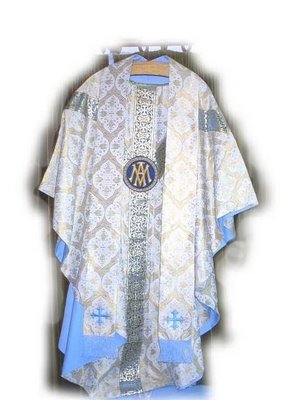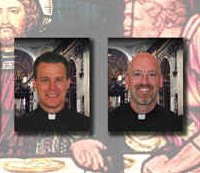Back in December of 2005, I posted some questions concerning the principles for organic development of the liturgy over at
LEI. Recently Shawn Tribe of
NLM reported to his readers about the Research Institute for Catholic Liturgy (
RICL) conference which featured Dr. Alcuin Reid, well-known priest, author and scholar (
The Organic Development of the Liturgy). Shawn's synthesis of Dr. Reid's talks led me to consider again this subject which from time to time resurfaces, especially when I'm studying the actual texts of ancient liturgies. Recently, I also blogged about NLM's
Theoretical Missal Project and my own experience with it gave me greater insight into the process of the development of the liturgy.
I don't claim to be able to formulate a strict definition of what constitutes organic development, though I'm closer to understanding the principles of organic development through the process of negation. As one reader of Shawn's article on the
RICL Conference notes: it's the bulk of the changes to the
Ordo Missae of the Roman Rite that tend to advertise that there just may be a break with organic development going on. The Theoretical Missal Project made me realize something else though. As I've continued my studies of the liturgy and especially as I've broken down the prayers of the
Ordo Missae (both classical and modern), I've come to the realization that it's not just the aggregate but also the individual parts that contribute to that aggregate which are examples of inorganic development. Mathematically it is self evident that if the aggregate shows signs of a break with tradition then it must be because the parts, or at least some parts, are breaks with tradition. I think that sometimes this is obscured when we isolate the prayers of the liturgy into it's rituals, and those rituals into their components, for analysis.
For example, in my own treatment of the revision of the
Confiteor, I made references to that of other liturgical uses to defend the orthodoxy of the result. I continue to affirm the orthodoxy of the Confiteor in the modern rite, but that somewhat misses the point doesn't it? The Second Vatican Council explicitly says that no innovations should be made unless the good of the Church certainly required it and also cautions that these innovations should develop from the forms already present. The addition of
et ommissione can certainly be understood on a theological basis as an alteration for the good of the Church, though it might be argued that it is at least not obvious that it was certainly required as such. The break in the form of the Confiteor to mirror the Dominican and Carthusian version does also draw from the liturgical richness of forms which already exist, while still maintaining certain aspects of the former tradition such as the triple
mea culpa. Yet, when one puts the result (i.e. aggregate) next to the former version does it not at least appear inorganic? To get a picture of what I'm talking about let's compare the versions with only a single alteration at a time.
Confíteor Deo omnipoténti, beátæ Maríæ semper Vírgini, beáto Michaéli Archángelo, beáto Joanni Baptístæ, sanctis Apóstolis Petro et Paulo, ómnibus Sanctis, et vobis, fratres (et tibi, Pater): quia peccávi nimis cogitatióne, verbo et ópere: mea culpa, mea culpa, mea máxima culpa. Ideo precor beátam Maríam semper Vírginem, beátum Michaélem Archángelum, beátum Joánnem Baptístam, sanctos Apóstolos Petrum et Paulum, omnes Sanctos, et vos, fratres (et te, Pater), oráre pro me ad Dóminum Deum nostrum.
Confíteor Deo omnipoténti, beátæ Maríæ semper Vírgini, beáto Michaéli Archángelo, beáto Joanni Baptístæ, sanctis Apóstolis Petro et Paulo, ómnibus Sanctis, et vobis, fratres( et tibi, Pater): quia peccávi nimis cogitatióne, verbo, ópere et omissione: mea culpa, mea culpa, mea máxima culpa. Ideo precor beátam Maríam semper Vírginem, beátum Michaélem Archángelum, beátum Joánnem Baptístam, sanctos Apóstolos Petrum et Paulum, omnes Sanctos, et vos, fratres (et te, Pater), oráre pro me ad Dóminum Deum nostrum.
Confíteor Deo omnipoténti, beátæ Maríæ semper Vírgini, beáto Michaéli Archángelo, beáto Joanni Baptístæ, sanctis Apóstolis Petro et Paulo, ómnibus Sanctis, et vobis, fratres: quia peccávi nimis cogitatióne, verbo et ópere: mea culpa, mea culpa, mea máxima culpa. Ideo precor beátam Maríam semper Vírginem, beátum Michaélem Archángelum, beátum Joánnem Baptístam, sanctos Apóstolos Petrum et Paulum, omnes Sanctos, et vobis, fratres, oráre pro me ad Dóminum Deum nostrum.
Confíteor Deo omnipoténti, (*) et vobis, fratres (et tibi, Pater): quia peccávi nimis cogitatióne, verbo et ópere: mea culpa, mea culpa, mea máxima culpa. Ideo precor beátam Maríam semper Vírginem, (*) omnes Angelos et Sanctos, et vos, fratres (et te, Pater), oráre pro me ad Dóminum Deum nostrum.
Confíteor Deo omnipoténti, (*) et vobis, fratres: quia peccávi nimis cogitatióne, verbo ópere et ommissione: mea culpa, mea culpa, mea máxima culpa. Ideo precor beátam Maríam semper Vírginem, (*) omnes Angelos et Sanctos, et vos, fratres, oráre pro me ad Dóminum Deum nostrum.As we look at each alteration to the
Confiteor as it had been used in the Roman Missal since at least the High Middle Ages the most striking innovation is the suppression of the list of saints (St. Michael, St. John the Baptist, and Sts. Peter and Paul). The second is the suppression of the alternating recitations by the Priest and then the server which results in a single recitation by all. The additions of
omissione and
Angelos seem relatively insignificant. The result is a product which does not seem to organically grow out of already existing forms. When we add to this the alteration of the rubrics (it is no longer said at the foot of the altar or bowing, the striking of the breast is reduced from three to one, and the recitation of the
Confiteor has become one of four Penitential Rite options, if we include the Aspersion Rite) the inorganic nature of the resultant product is even more glaring. Such an exercise also helps us to identify the portions of inorganic alterations as being primarily that of the suppression of the named saints, the reduction to a single recitation, and the alteration of the rubrics. More importantly this example is one that is of a minor ritual considered among the more important and extensive alterations to the missal.
Thus, we can begin to see what is meant by the accusation that the reformed liturgy is a banal on-the-spot fabrication using materials from which the classical liturgy had been formed. The restructuring of these materials by a committee of so-called experts and the resulting product is exactly what gives the impression that the liturgy is what we make of it rather than something that is handed on from tradition. One reader of NLM made the very astute point:
"Few of the changes on their own cannot be defended [as to their orthodoxy]. Few of the prayers we have are without merit, as anyone who has followed Fr. Zuhlsdorf's translations of the proper prayers of the day can easily see. Most of them, indeed, are derived from ancient Western sacramentaries.Even the prayers for the Preparation of the Gifts have their excellencies--Pope Benedict used them beautifully for his homily today on Corpus Christi. And he CHOSE to use the Second Eucharistic Prayer--and on a great Feast Day, too. How it will be improved by phrases such as, "the dew of your Spirit"! I believe Ratzinger hopes that the Novus Ordo will become organic over time, in a backwards fashion, if you like, through infusion of older forms and a return of the 'spirit' of the Roman liturgy operating on materials that are not entirely unworthy, by any means. I think where Ratzinger parts from many traditionalists is that he accepts that the changes in fact have been made and that we must FIRST learn to receive them anew and infuse them with a liturgical spirit before any substantial changes can be made. THOSE changes--whatever they may be--will have to be made over a long time under the guidance of the Holy Spirit. A parallel return to and reacquaintance with the older forms will help THAT process to be an organic one and return to the liturgy those essential elements--whether in old or new forms--that may have been lost. There is no HELP for the fact that a process that seemed--and in some ways WAS--artificial was used in the past. The result is now the normative liturgy of the Church. The processes outlined above (and proposed in God and the World and other places) are what we must rely on to "de-artificialize" the forms of our worship. An illustration of Ratzinger's perhaps paradoxical seeming attitude can be gleaned from yesterday's Corpus Christi Mass. The Pope deliberately chose--as he has at least once before (in Bari last year)--to use the Second Eucharistic Prayer. And in his homily, he drew from the words of the Prayers in Preparation of the Gifts (the ones that replace the Offertory Prayers, beginning with "Blessed are you, Lord God of all Creation, through your goodness we have this bread to offer..."). He sets us an example of the Pope being UNDER the liturgy and RECEIVING it along with the rest of us. This spirit, which he recommends to all of us, will in the end do more for liturgical tradition than many an obstreperous attitude." [brackets mine for clarification]JeffI think Jeff has got it exactly right. Whatever the criticisms of the reformed liturgy, we too must be careful not to add to the errors of the reformers by solidifying the application of faulty principles of reform. Even if the goal is laudable we cannot allow the process of "reverse engineering" those faulty reforms to add to the destruction of the spirit of the liturgy and the conception of the liturgy as a technical production of experts. If we succumb to these same principles that led the Concilium and earlier reformers astray we will fall prey to the same faults that they did. For if we achieved the reestablishing of the traditional liturgy in all the Roman parishes around the world, it would be viewed by those displeased at such a triumph as nothing other than the liturgical opinions and desires of experts that happened this time to be ultra conservative or traditionalists. And so they would simply set about, once again, planning the destruction of our liturgical heritage. Let us note the example of Benedict XVI and likewise set about recovering what is lost to the liturgy according to right principles.
 Vestments are those clothings worn for the liturgical rites. I'm often surprised by the inappropriate and cheap vestments that I've seen used in parishes. I'm not simply noting those vestments regularly seen which are worn, frayed, soiled, stained, wrinkled, etc. I'm talking about the quality of the vestment and it's appearance even when new. There are a variety of companies out there that provide liturgical supplies and for the large part their offerings in the category of vestments are ugly, of cheap quality while still managing to draw an exorbitant price, and often entirely inappropriate for use in liturgical rites.
Vestments are those clothings worn for the liturgical rites. I'm often surprised by the inappropriate and cheap vestments that I've seen used in parishes. I'm not simply noting those vestments regularly seen which are worn, frayed, soiled, stained, wrinkled, etc. I'm talking about the quality of the vestment and it's appearance even when new. There are a variety of companies out there that provide liturgical supplies and for the large part their offerings in the category of vestments are ugly, of cheap quality while still managing to draw an exorbitant price, and often entirely inappropriate for use in liturgical rites.